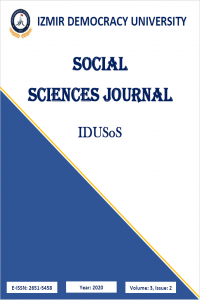ENDÜSTRİ 4.0 ÜRETİM SÜRECİNDE SÜREÇ DEĞİŞKENLİĞİNİN OPTİMİZASYONUNDA HEIJUNKA YÖNTEMİ
Yalın Yönetim, Üretim Yönetim Optimizasyonu, Yönetim Bilişim Sistemleri, Heijunka, Endüstri 4.0 ve Endüstride Yeni Yaklaşımlar, Üretim Yönetimi
HEIJUNKA METHOD FOR THE OPTIMIZATION OF PROCESS VARIANCE WITHIN THE FRAME OF INDUSTRY 4.0
Lean Management, Optimization of Production Management, Management Information System, Heijunka, Industry 4.0 and New Approach at Industry Management, Production Management,
___
- Boysen, N., Fliedner, M. and Scholl, A. (2007). Sequencing mixed-model assembly lines: survey, classification and model critique. European journal of operational research, [In Press, Corrected Proof]. (Hakansson)
- Çetin Gerger, G. (2019). Tax Services and Tax Service Providers’ Changing Role in the IoT and AmI Environment. In: Mahmood Z. (eds) Guide to Ambient Intelligence in the IoT Environment. Computer Communications and Networks. Cham: Springer.
- Coleman, B. Jay and Vaghefi, M. Reza (1994). Heijunka (?): A key to the Toyota production system. Production and Inventory Management Journal; Fourth Quarter 1994; 35, 4; ProQuest Central, pg. 31-35.
- Dave, Y. and Sohani, N. (2012). Single Minute Exchange of Dies: Literature Review. International Journal of Lean Thinking, Volume 3, Issues 2 (December 2012).
- Gerger, A. (2017). Use Of Six Sigma Method As A Process Improvement Technique (Unpublished undergraduate dissertation). Dokuz Eylül University, Izmir.
- Gerger, A. and Firuzan, A. R. (2012). Reasons of Failure in Lean Six Sigma Projects. International Journal of Multidisciplinary Thought, 2 (3), 123–130.
- Hakansson, J., Skoog, E. and Eriksson, K. A review of assembly line balancing and sequencing including line layouts. University west Department of Engineering Science 461 86 Trollhattan.
- İşler, M. and Güner, M. (2014). Heijunka Technique from Lean Production Tools and Its Apparel Applications. 8th International Izmir Textile and Apparel Symposium, April 2-5, 353-356.
- Jones, D. T. (2006). Heijunka: Leveling production. Manufacturing engineering, 37(2), 29-36.
- Liker, J. K. (2004). The Toyota way: 14 management principles from the world's greatest manufacturer. NY: McGraw-Hill.
- Lippolt, C.R. and Furmans, K. (2008). Sizing of Heijunka-controlled Production Systems with Unreliable Production Processes. IFIP International Federation for Information Processing, Volume 257, Lean Business Systems and Beyond, Tomasz Koch, ed.; (Boston: Springer), pp. 11–19.
- Matzka, J., Mascolo, M.D. and Furmans, K. (2012). Buffer sizing of a Heijunka Kanban system. J Intell Manuf (2012) 23:49–60, DOI 10.1007/s10845-009-0317-3
- Ramekar, A. M., Muneshwar, V.D., Kute, A.S. and Choube, A.M. (2017). Concept of Heijunka. International Advanced Research Journal in Science, Engineering and Technology, Vol. 4, Special Issue 3, January 2017, DOI 10.17148/IARJSET.
- Rizvi, H. R. (2013). Application of Lean-Six Sigma Approach in a Laboratory Experimental Case Study. International Journal of Lean Thinking, Volume 4, Issue 2 (December2013).
- Sharma, M. (2017). What is Heijunka and what are Muda Muri & Mura?. Çevrimiçi https://www.youtube.com/watch?v=sRbG_zjsrPs&t=141s
- Shingo, S. (1985). A Revolution in Manufacturing: The SMED System. Portland: Productivity Press Inc.
- Swanson, R. E. (2008). A Generalized Approach to Demand Buffering and Production Levelling for JIT Make- to-Stock Applications. The Canadian Journal of Chemical Engineering, Volume 86, October 2008, DOI 10.1002/cjce.20093.
- Taleghani, M. (2010). Key factors for implementing the lean manufacturing system. Journal of American Science, 6 (7), 287-291.
- Womack, J. P. and Jones, D. T. (1996). Lean Thinking: Banish Waste and Create Wealth in Your Corporation. NY: Simon & Schuster.
- Başlangıç: 2018
- Yayıncı: İzmir Demokrasi Üniversitesi
OSMANLI İMPARATORLUĞU’NDA EFES HARABELERİ’NİN İNGİLTERE’YE GÖTÜRÜLMESİ ÜZERİNE BAZI DÜŞÜNCELER
Sıdıka TAMTÜRK, Bayram BAYRAKDAR
TURİZM SEKTÖRÜNDE CİNSİYETE DAYALI ÜCRET AYRIMCILIĞI
LANCHESTER N2 KANUNUNUN PREVEZE DENİZ ZAFERİNE UYARLANMASI VE ALTERNATİF SENARYOLARIN ANALİZİ
THE ANALYSIS OF UKRAINIAN CRISES’ EFFECTS ON BELARUS-RUSSIA BILATERAL RELATIONS
Veranika TAUSTYKH, Gökhan DUMAN
ENDÜSTRİ 4.0 ÜRETİM SÜRECİNDE SÜREÇ DEĞİŞKENLİĞİNİN OPTİMİZASYONUNDA HEIJUNKA YÖNTEMİ
